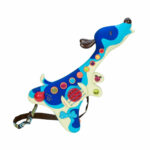The Dmaj7 guitar chord, also known as D major seventh, brings a rich, mellow, and sophisticated sound to your guitar playing. It’s a beautiful chord that adds a touch of jazz and complexity to progressions, moving beyond the standard major triad. This guide will explore various ways to play the Dmaj7 chord, delve into its music theory, and provide tips to incorporate it into your guitar repertoire.
Unveiling the Open Dmaj7 Chord
The most common and arguably easiest way to play the Dmaj7 is in the open position. This voicing is bright and resonant, perfect for adding color to folk, pop, and even jazz tunes.
To play this open Dmaj7:
- Place your index finger across the high E, B, and G strings at the 2nd fret. This effectively creates a mini-barre.
- Leave the D, A, and low E strings open.
- Strum from the D string downwards, avoiding the lower A and E strings for this voicing.
This open Dmaj7 is a great starting point and offers a wonderfully sweet sound.
Exploring Alternative Dmaj7 Chord Shapes
While the open position is popular, exploring other shapes across the fretboard expands your sonic palette and provides flexibility in different musical contexts.
Barre Chord Dmaj7 Shape
Barre chords are essential for guitarists, and the Dmaj7 is no exception. This barre shape allows you to play the Dmaj7 higher up the neck and transition smoothly from other barre chords.
To form this Dmaj7 barre chord:
- Barre your index finger across all six strings at the 5th fret.
- Place your middle finger on the G string at the 6th fret.
- Place your ring finger on the B string at the 7th fret.
- Place your pinky finger on the high E string at the 7th fret.
- Strum all six strings.
This barre chord shape provides a fuller, more powerful Dmaj7 sound, suitable for genres like rock and pop.
Another Dmaj7 Voicing
Here’s another useful voicing of Dmaj7, offering a different tonal color and finger placement challenge.
To play this Dmaj7 shape:
- Place your index finger on the G string at the 9th fret.
- Place your middle finger on the high E string at the 9th fret.
- Place your ring finger on the B string at the 10th fret.
- Place your pinky finger on the D string at the 12th fret.
- Avoid strumming the lower E and A strings.
This voicing is higher up the neck and provides a brighter, more shimmering Dmaj7 sound, great for melodies and lead guitar work.
Dmaj7 Chord Theory and Musical Context
Understanding the theory behind the Dmaj7 chord enhances your musical comprehension and allows you to use it more effectively.
Notes within the Dmaj7 Chord
The Dmaj7 chord is built from four notes:
- D (Root)
- F# (Major Third)
- A (Perfect Fifth)
- C# (Major Seventh)
These notes create the characteristic major seventh sound, adding a jazzy and sophisticated flavor compared to a simple D major chord (D, F#, A).
Dmaj7 in Chord Progressions
The Dmaj7 chord is commonly used in various musical genres. It often appears as a substitute for a regular D major chord to add harmonic interest. Try it in progressions like:
- Em9 – A7 – Dmaj7: This classic jazz progression showcases the smooth sound of the Dmaj7. (See diagrams in pdf)
Chord Name Variations
You might see Dmaj7 written in a few different ways:
- Dmaj7: The most common abbreviation.
- D major 7th: The full name.
- DM7: Another frequent abbreviation.
- DΔ7: Using the triangle (delta) symbol, a more formal notation.
All these notations refer to the same D major seventh chord.
Dmaj7 Inversions and Slash Chords
Exploring inversions of the Dmaj7 chord adds further versatility to your playing. Inversions are created by changing the bass note of the chord.
Here are some Dmaj7 inversions:
- Dmaj7/F#: The first inversion, with F# as the bass note. (Fingering: 200222)
- Dmaj7/A: The second inversion, with A as the bass note. (Fingering: X00222)
- Dmaj7/C#: The third inversion, with C# as the bass note. (Fingering: X32422 or similar)
- Dmaj7/B: Another interesting slash chord variation. (Fingering: X20222)
- Dmaj7/G: Creates a unique harmonic color. (Fingering: 300222)
- Dmaj7/E: Theoretically similar to Dmaj9/E. (Fingering: 000222)
These slash chords offer different bass lines and harmonic textures, expanding your creative possibilities. (Diagrams of inversions can provide visual guidance.)
Conclusion: Embrace the Dmaj7 Chord
The Dmaj7 guitar chord is a valuable addition to any guitarist’s chord vocabulary. From its mellow open voicing to its versatile barre chord shape and theoretical depth, the Dmaj7 opens up new sonic avenues. Experiment with these different shapes, understand its theory, and start incorporating the Dmaj7 into your chord progressions and songs to add a touch of sophistication and beauty to your guitar playing. Keep practicing and exploring the rich world of guitar chords!

